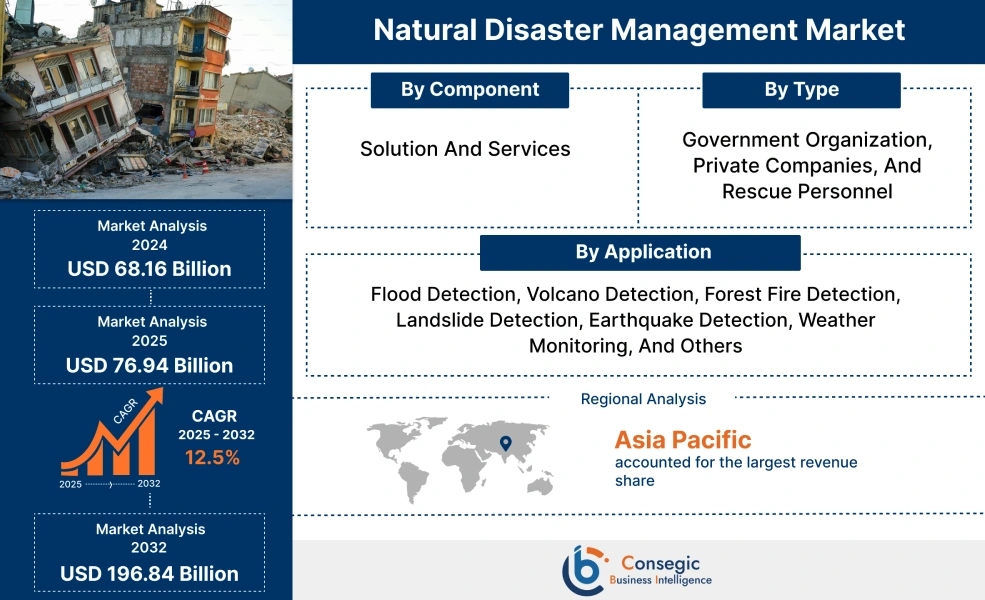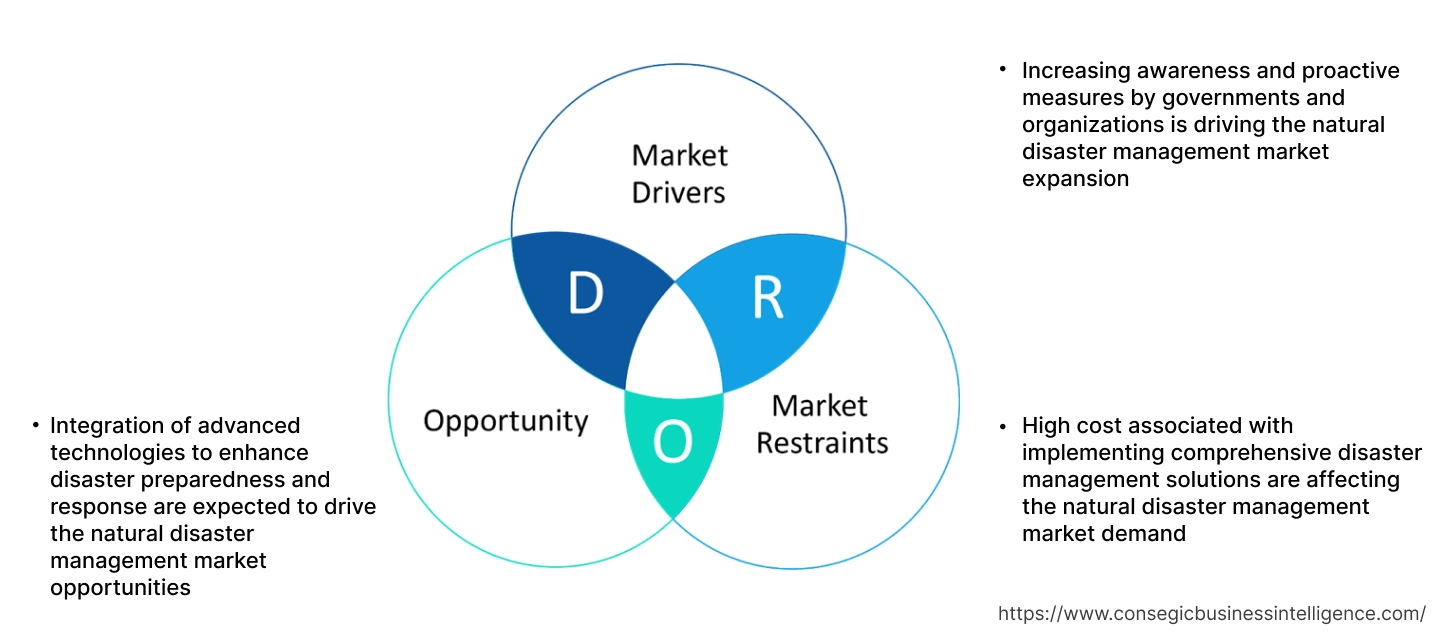Natural Disaster Management Market Size:
Natural Disaster Management Market Size is estimated to reach over USD 196.84 Billion by 2032 from a value of USD 68.16 Billion in 2024 and is projected to grow by USD 76.94 Billion in 2025, growing at a CAGR of 12.5% from 2025 to 2032.
Natural Disaster Management Market Scope & Overview:
Natural disaster management is a proactive and reactive process involving planning, preparedness, response, and recovery from events like earthquakes, floods, and hurricanes. It focuses on reducing the impact of disasters and minimizing loss of life, property, and infrastructure. Key aspects include preventing disasters, preparing communities, responding effectively during emergencies, and assisting in recovery.
Natural Disaster Management Market Dynamics - (DRO) :
Key Drivers:
Increasing awareness and proactive measures by governments and organizations is driving the natural disaster management market expansion
Governments worldwide are investing heavily in disaster management infrastructure and systems to minimize the impact of disasters on populations and economies. Policies and regulations mandating natural disaster management solutions and response protocols have been established by several, further driving the adoption of disaster management solutions and services. Organizations are also recognizing the importance of disaster preparedness and are adopting comprehensive disaster recovery and business continuity plans.
In the realm of disaster management, the role of crisis management service is becoming increasingly pivotal. These services are designed to provide structured and strategic responses to crises, ensuring that organizations can navigate through emergencies with minimal disruption. By incorporating these services into their disaster preparedness strategies, organizations can enhance their resilience against unforeseen events. This proactive appraising helps in managing immediate crises but also in mitigating long-term impacts on operations and reputation.
- For instance, Government of India launched the Bhookamp app, which provides real-time earthquake information to users.
Thus, according to the natural disaster management market analysis, the increasing awareness and proactive measures by governments and organizations is driving the natural disaster management market size.
Key Restraints:
High cost associated with implementing comprehensive disaster management solutions are affecting the natural disaster management market demand
Advanced technologies and infrastructure investments require substantial financial resources, which may be a constraint for some organizations and governments, particularly in developing regions. Additionally, the complexity of coordinating disaster management efforts across multiple stakeholders, including government agencies, private sector organizations, and non-governmental organizations, can pose challenges. Thus, the aforementioned factors would further impact the natural disaster management market size.
Future Opportunities :
Integration of advanced technologies to enhance disaster preparedness and response are expected to drive the natural disaster management market opportunities
The integration of technologies such as AI, the Internet of Things (IoT), and machine learning is revolutionizing disaster management. AI's ability to analyze extensive data for forecasting natural disasters, combined with IoT devices providing real-time on-site information, greatly improves the precision of predictions and the efficiency of response efforts. This technological adoption represents a major area of expansion for companies within the disaster management industry.
- For instance, in February 2025, Vantiq and NTT Data have expanded their partnership to incorporate advanced AI into NTT DATA's D-Resilio platform. This AI integration, which began in April 2025, aims to enhance real-time understanding of disaster situations and refine emergency response plans, empowering communities to act effectively during crises.
Thus, based on the above natural disaster management market analysis, the integration of advanced technologies to enhance disaster preparedness and response are expected to drive the natural disaster management market opportunities and growth.
Natural Disaster Management Market Segmental Analysis :
By Component:
Based on component, the market is segmented into solution and services.
Trends in the component:
- As disasters become more intricate and widespread, there is a growing need for comprehensive and adaptable solutions to manage them effectively.
- The rising incidents of data breaches and stringent regulatory requirements for data protection are significant drivers for this segment.
- Thus, based on the above analysis, these factors are driving the natural disaster management market demand and growth.
The solution segment accounted for the largest revenue share in the year 2024.
- Emergency communication solutions including satellite phones, emergency broadcasting systems, and early warning systems, play a crucial role in disaster management by ensuring that accurate and timely information is disseminated to all stakeholders during an emergency.
- Monitoring and detection systems leverage advanced technologies such as sensors, drones, and Geographic Information Systems (GIS) to detect and monitor potential disaster threats in real-time.
- For instance, in April 2025, the African Development Bank, the Mozambican government, and Busan Technopark from Korea teamed up on a new initiative to boost disaster preparedness in Mozambique using drones. This project will create a drone training center in Mozambique to educate 30 professionals, including 10 instructors. It will also put a drone-based monitoring and response system in place across five flood-prone areas.
- Thus, based on the above analysis, these developments are further driving the natural disaster management market growth and trends.
The services segment is anticipated to register the fastest CAGR during the forecast period.
- Consulting services are essential for helping organizations develop and implement effective disaster management plans. These services include risk assessments, vulnerability analyses, and the development of customized disaster response strategies.
- Training and education services play a vital role in enhancing the preparedness of individuals and organizations for disaster situations. By providing comprehensive training and education, these services ensure that all stakeholders are equipped with the knowledge and skills needed to respond to disasters effectively.
- Effective public information services ensure that individuals receive accurate and timely information, enabling them to take appropriate actions to protect themselves and their families.
- Thus, the above factors are expected to drive the natural disaster management market share and trends during the forecast period.
By Application:
Based on the application, the natural disaster management market is segmented into flood detection, volcano detection, forest fire detection, landslide detection, earthquake detection, weather monitoring, and others.
Trends in the application:
- The adoption of AI, Machine Learning (ML), IoT, drones, big data analytics, GIS, and satellite remote sensing is transforming every phase of the disaster management cycle. This is moving from reactive to proactive approaches.
- The rising economic costs associated with natural disasters motivate investments in preventative measures and efficient response systems to minimize financial impact.
- Thus, the above factors are driving the natural disaster management market trends and growth during the forecast period.
The flood detection accounted for the largest revenue share in the year 2024.
- As global climate patterns shift, many regions are experiencing unprecedented weather conditions, including heavy rainfall and rising sea levels, which lead to more frequent and severe flooding. This has created a pressing demand for advanced flood monitoring systems that can provide real-time data and early warning.
- Governments and private organizations are increasingly investing in these technologies to enhance their flood monitoring capabilities and improve their emergency response strategies.
- Thus, based on the above analysis, these factors would further supplement the natural disaster management market share and trends.
The landslide detection segment is anticipated to register the fastest CAGR during the forecast period.
- Governments and communities are prioritizing the implementation of integrated EWS that combine sensor data, meteorological forecasts, and predictive models to provide actionable alerts to at-risk populations.
- While global technologies are adopted, there is a growing demand for localized solutions that consider specific geological, climatic, and socio-economic conditions of a region. This includes tailoring sensor networks, data processing algorithms, and warning dissemination strategies.
- The maturation of GIS for mapping and spatial analysis, coupled with remote sensing data, provides a powerful foundation for understanding landslide susceptibility and monitoring changes over time.
- Thus, these trends would further supplement the natural disaster management market during the forecast period.
By End Use:
Based on end use, the market is segmented into government organization, private companies, and rescue personnel.
Trends in the end use:
- Governments worldwide are recognizing the importance of disaster management in protecting their economies. This has led to the implementation of policies and regulations mandating disaster management plans and the allocation of significant funds.
- The global trend towards building smart cities integrates disaster management into urban planning, using technology to enhance resilience and safety, driving the demand for integrated solutions.
- These factors are anticipated to further drive the natural disaster management market trends during the forecast period.
The government organization segment accounted for the largest revenue share of 43.13% in the year 2024 and is expected to register the highest CAGR during the forecast period.
- The government sector is also a major adopter of disaster recovery solutions, driven by the demand to protect sensitive data and ensure continuity of public services.
- Government agencies handle critical data related to national security, public safety, and citizen services, necessitating robust disaster recovery plans to prevent data loss and ensure uninterrupted operations.
- The increasing digitization of government services and the growing threat of cyber-attacks targeting government infrastructure are significant drivers for DR solutions in this industry.
- Thus, based on the above analysis, these factors are driving the natural disaster management market growth.
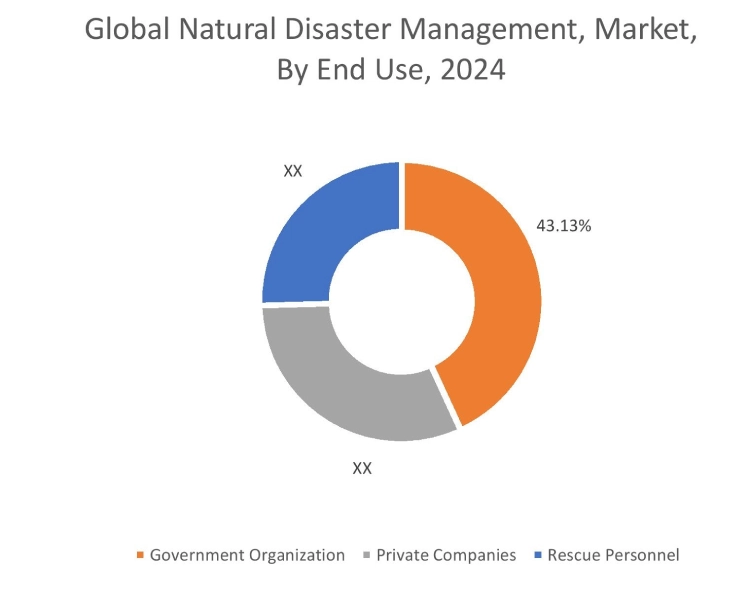
Regional Analysis:
The global market has been classified by region into North America, Europe, Asia-Pacific, Middle East & Africa (MEA), and Latin America.
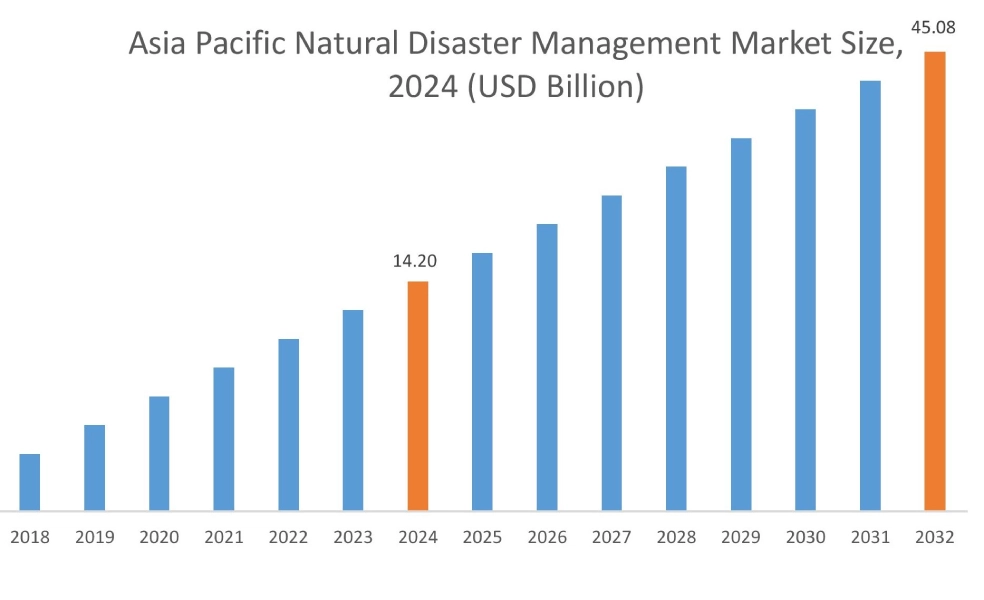
Asia Pacific natural disaster management market expansion is estimated to reach over USD 45.08 billion by 2032 from a value of USD 14.20 billion in 2024 and is projected to grow by USD 16.17 billion in 2025. Out of this, the China market accounted for the maximum revenue split of 39.88%. The region's increasing vulnerability to natural disasters, such as earthquakes, tsunamis, and typhoons, has necessitated the adoption of comprehensive disaster management solutions. Countries in the region are investing heavily in disaster preparedness infrastructure, including early warning systems, evacuation planning, and emergency response services. Further, government initiatives and international aid programs further support the growth of the disaster management market in the region. These factors would further drive the regional natural disaster management market during the forecast period.
- For instance, in June 2025, during the eighth Global Platform for Disaster Risk Reduction (GPDRR) 2025 in Geneva, the Indian government showcased its robust disaster risk reduction (DRR) financing, which has now reached over USD 28 billion (Rs. 2,40,324 crore) cumulatively. India stressed the need for concrete, measurable results and proposed creating a global fund specifically for catalytic financing, technical assistance, and sharing expertise in DRR.
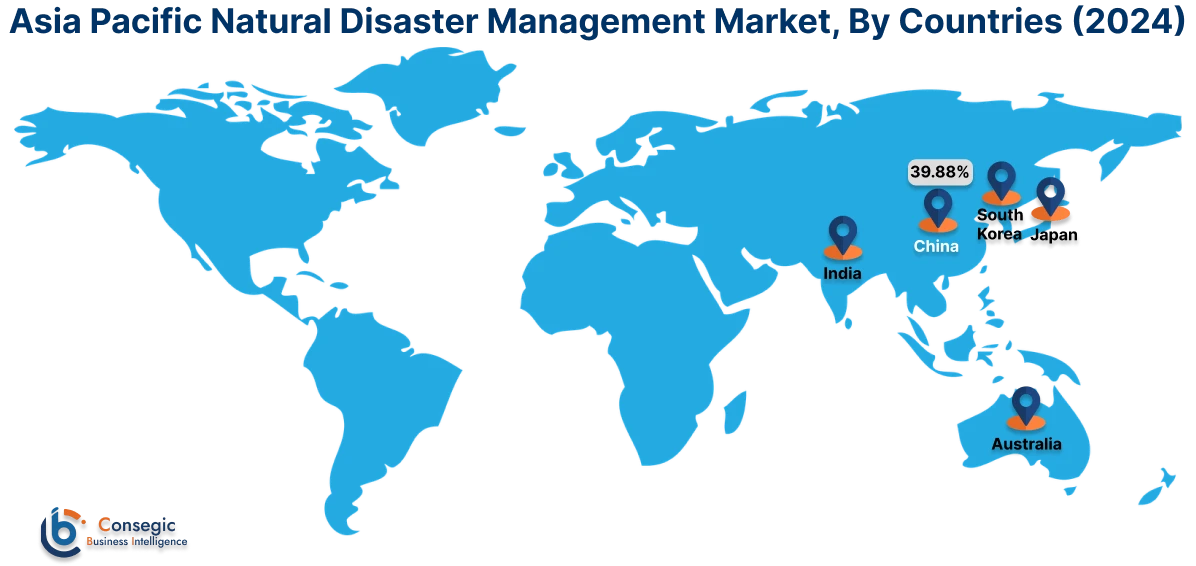
North America market is estimated to reach over USD 88.38 billion by 2032 from a value of USD 30.92 billion in 2024 and is projected to grow by USD 34.87 billion in 2025. North America is a major player in the global disaster management market, largely due to its strict government regulations and substantial investments in preparedness and response. The region's advanced technology and proactive government initiatives solidify its leading market position. The United States, in particular, boasts strong disaster management systems, including early warning and emergency operation centers, further boosting North America's disaster preparedness and driving market growth. These factors would further drive the market in North America.
According to the analysis, the natural disaster management industry in Europe is anticipated to witness significant development during the forecast period. The European Union has implemented various policies and initiatives to enhance disaster resilience, including the European Civil Protection Mechanism, which facilitates coordinated disaster response efforts among member states. Additionally, the urbanization in Latin America leads to dense populations in informal settlements (favelas, barrios) often located in high-risk areas (e.g., hillsides prone to landslides, floodplains). This focuses on strengthening urban resilience. Further, countries in the Gulf Cooperation Council (GCC) are investing heavily in smart city technologies that integrate disaster management solutions, including advanced sensor networks, intelligent traffic management for evacuations, and sophisticated command and control centers.
Top Key Players and Market Share Insights:
The global natural disaster management market is highly competitive with major players providing solutions and services to the national and international markets. Key players are adopting several strategies in research and development (R&D), product innovation, and end-user launches to hold a strong position in the market. Key players in the natural disaster management industry include-
- IBM Corporation (U.S.)
- Honeywell International Inc. (U.S.)
- Trimble Inc. (U.S.)
- Tetra Tech, Inc. (U.S.)
- Fluor Corporation (U.S.)
- AECOM (U.S.)
- Jacobs Engineering Group Inc. (U.S.)
- Black & Veatch Holding Company (U.S.)
- Siemens AG (Germany)
- Lockheed Martin Corporation (U.S.)
- Northrop Grumman Corporation (U.S.)
- General Dynamics Corporation (U.S.)
- Hexagon AB (Sweden)
- Intergraph Corporation (U.S.)
- Everbridge, Inc. (U.S.)
- Atos SE (France)
Natural Disaster Management Market Report Insights :
| Report Attributes | Report Details |
| Study Timeline | 2019-2032 |
| Market Size in 2032 | USD 196.84 Billion |
| CAGR (2025-2032) | 12.5% |
| By Component |
|
| By Application |
|
| By End Use |
|
| By Region |
|
| Key Players |
|
| North America | U.S. Canada Mexico |
| Europe | U.K. Germany France Spain Italy Russia Benelux Rest of Europe |
| APAC | China South Korea Japan India Australia ASEAN Rest of Asia-Pacific |
| Middle East and Africa | GCC Turkey South Africa Rest of MEA |
| LATAM | Brazil Argentina Chile Rest of LATAM |
| Report Coverage |
|
Key Questions Answered in the Report
How big is the Natural Disaster Management Market? +
Natural Disaster Management market size is estimated to reach over USD 196.84 Billion by 2032 from a value of USD 68.16 Billion in 2024 and is projected to grow by USD 76.94 Billion in 2025, growing at a CAGR of 12.5% from 2025 to 2032.
Which is the fastest-growing region in the Natural Disaster Management Market? +
Asia-Pacific region is experiencing the most rapid growth in the market.
What specific segmentation details are covered in the Natural Disaster Management report? +
The natural disaster management report includes specific segmentation details for component, application, end use, and region.
Who are the major players in the Natural Disaster Management Market? +
The key participants in the market are IBM Corporation (U.S.), Honeywell International Inc. (U.S.), Siemens AG (Germany), Lockheed Martin Corporation (U.S.), Northrop Grumman Corporation (U.S.), General Dynamics Corporation (U.S.), Hexagon AB (Sweden), Intergraph Corporation (U.S.), Everbridge, Inc. (U.S.), Atos SE (France), Trimble Inc. (U.S.), Tetra Tech, Inc. (U.S.), Fluor Corporation (U.S.), AECOM (U.S.), Jacobs Engineering Group Inc. (U.S.), Black & Veatch Holding Company (U.S.), and others.
